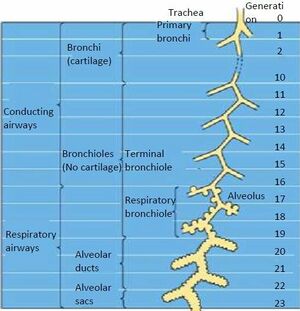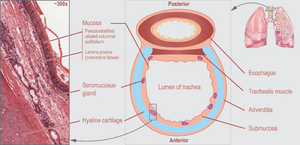Tracheobronchial Tree: Difference between revisions
mNo edit summary |
mNo edit summary |
||
| Line 15: | Line 15: | ||
Main function of the tracheobronchial tree is to allow the transport of air to from the environment to the lungs for gas exchange. | Main function of the tracheobronchial tree is to allow the transport of air to from the environment to the lungs for gas exchange. | ||
[[File:Branching-generation-of-the-airways-1.jpg|thumb]] | [[File:Branching-generation-of-the-airways-1.jpg|thumb]] | ||
In all, there are approximately 23 generations (divisions) of airway in the human lung extending from trachea (generation 0) to the last order of terminal bronchioles (generation 23). | In all, there are approximately 23 generations (divisions) of airway in the human lung extending from trachea (generation 0) to the last order of terminal bronchioles (generation 23). | ||
* 0 generation - Trachea = Is design as generation zero. | |||
* 1 generation - Primary bronchi | |||
* 2 generation - Lobar brochi. | |||
* 3 generation - Segmental bronchi | |||
* 4 generations - subsegmental bronchus | |||
* 17 -22 generations of divisions = Bronchioles | |||
* 23 - Alveolar duct | |||
Terminal Bronchioles = is 16 th is general of divinsions | |||
== Trachea == | == Trachea == | ||
The trachea is a | The primary function of the trachea is to allow passage of inspired and expired air into and out of the lung. | ||
The trachea is a C-shaped structure, flexible tube that is composed of '''hyaline cartilage on the anterior and lateral walls''', with the trachealis smooth muscle forming the posterior border of the trachea .Also the trachea is composed of several primary structural annular ligament.https://www.sciencedirect.com/topics/medicine-and-dentistry/trachealis-muscle , [https://www.ncbi.nlm.nih.gov/books/NBK448070/ https://www.ncbi.nlm.nih.gov/books/NBK448070/.] Posterior surface of the trachea is flat where its cartilaginous rings are incomplete and where it is related to the esophagus. (anatomy book ). | |||
# The trachea descends from the larynx into the lung.https://www.ncbi.nlm.nih.gov/books/NBK556044/#:~:text=The%20tracheobronchial%20tree%20is%20composed,the%20lungs%20for%20gas%20exchange. | # The trachea descends from the larynx into the lung.https://www.ncbi.nlm.nih.gov/books/NBK556044/#:~:text=The%20tracheobronchial%20tree%20is%20composed,the%20lungs%20for%20gas%20exchange. | ||
| Line 38: | Line 46: | ||
The trachealis muscle found in the posterior wall of trachea. | The trachealis muscle found in the posterior wall of trachea. | ||
===== '''Hyaline cartilage''' ===== | ===== '''Hyaline cartilage''' ===== | ||
| Line 47: | Line 52: | ||
===== '''Trachealis muscle''' ===== | ===== '''Trachealis muscle''' ===== | ||
* Type of muscle = Smooth muscle | * Type of muscle = Smooth muscle | ||
* Connects the ends of the C-shaped tracheal cartilages | * Connects the ends of the C-shaped tracheal cartilages. | ||
* The trachealis muscle functions to constrict the airway by pulling the cartilages together, decrease the diameter , allowing for increased expiratory force during coughing with the smaller aperture allowing greater velocity to be achieved and the particle to be expelled. http://education.med.nyu.edu/Histology/courseware/modules/respiratory-sy/respiratory.07.html | * Is in contact with the anterior esophagus[[File:Cross section trachea.png|thumb|300x300px]]The trachealis muscle functions to constrict the airway by pulling the cartilages together, decrease the diameter , allowing for increased expiratory force during coughing with the smaller aperture allowing greater velocity to be achieved and the particle to be expelled. http://education.med.nyu.edu/Histology/courseware/modules/respiratory-sy/respiratory.07.html. This action is helpful, especially when eating food, which requires the expansion of the esophagus. | ||
This action is helpful, especially when eating food, which requires the expansion of the esophagus. | |||
==== Bronchi ==== | ==== Bronchi ==== | ||
| Line 60: | Line 61: | ||
[https://www.sciencedirect.com/topics/medicine-and-dentistry/trachealis-muscle https://www.sciencedirect.com/topics/medicine-and-dentistry/trachealis-musclehttps://www.sciencedirect.com/topics/medicine-and-dentistry/trachealis-muscle] | [https://www.sciencedirect.com/topics/medicine-and-dentistry/trachealis-muscle https://www.sciencedirect.com/topics/medicine-and-dentistry/trachealis-musclehttps://www.sciencedirect.com/topics/medicine-and-dentistry/trachealis-muscle] | ||
< | == Bronchi == | ||
The trachea divides at the carina (at the level of the sternal angle) to give rise to the two primary bronchi – '''the right and left bronchus''' (figure X). Differences between right and left bronchus are illustrated below in table X .The right and left bronchus conduct air from the trachea into the right and left lung respectively. | |||
The '''primary bronchi''' then branch into s'''econdary bronchi (lobar bronchi)''' – three on the right and two on the left. Each secondary bronchus supplies a lobe of the lung. | |||
* | Each secondary bronchi (lobar bronchi) subsequently divide into narrower '''tertiary bronchi (segmental bronchi)''' that supply bronchopulmonary segments (largest subdivisions of a lobe). | ||
** | |||
** | '''Segmental bronchi''' undergo further branching to form numerous smaller airways, called the '''bronchioles,''' . | ||
{| class="wikitable" | |||
|'''Right Bronchus''' | |||
|'''Left Bronchus''' | |||
|- | |||
|<nowiki>- Wider</nowiki> | |||
- More vertical | |||
- Shorter (2-3cm) | |||
- Supported by C shaped cartilages | |||
- 20 to 30 degree angle | |||
|<nowiki>- Narrower</nowiki> | |||
- More angular | |||
- Longer (5cm) | |||
- Supported by C shaped cartilages | |||
- 40 to 60 degree angle | |||
|} | |||
=== Bronchioles === | |||
Bronchioles arise from segmental bronchi and represent the smaller branches of the bronchial tree. | |||
Bronchioles differ histologically from bronchi as they lack C shaped cartilages in their walls. | |||
Bronchioles initially divide into many generations of '''conducting bronchioles''' that eventually divide further into '''terminal bronchioles''' which further divide into r'''espiratory bronchioles'''. | |||
* '''Conducting bronchioles –''' segmental bronchi give rise to 20 to 25 generations of conducting bronchioles that further divide to terminal bronchioles. | |||
** '''Terminal bronchioles –''' represent the last part of the conducting part of the bronchial tree and give rise to several generations of respiratory bronchiole | |||
*** '''Respiratory bronchioles-''' distinguishable to other types of bronchioles by the presence thin walled outpocketing (alveoli) extending from their lumens. Therefore, represent the first part of the respiratory airways where they facilitate gas exchange. | |||
== Resources == | == Resources == | ||
*bulleted list | *bulleted list | ||
Revision as of 14:26, 20 April 2022
Original Editor - User Name
Top Contributors - Stella Constantinides and Kim Jackson
Introduction[edit | edit source]
The tracheobronchial tree is a branching tree of airways composed of:
- the trachea
- the bronchi
- the bronchioles.
Main function of the tracheobronchial tree is to allow the transport of air to from the environment to the lungs for gas exchange.
In all, there are approximately 23 generations (divisions) of airway in the human lung extending from trachea (generation 0) to the last order of terminal bronchioles (generation 23).
- 0 generation - Trachea = Is design as generation zero.
- 1 generation - Primary bronchi
- 2 generation - Lobar brochi.
- 3 generation - Segmental bronchi
- 4 generations - subsegmental bronchus
- 17 -22 generations of divisions = Bronchioles
- 23 - Alveolar duct
Terminal Bronchioles = is 16 th is general of divinsions
Trachea[edit | edit source]
The primary function of the trachea is to allow passage of inspired and expired air into and out of the lung.
The trachea is a C-shaped structure, flexible tube that is composed of hyaline cartilage on the anterior and lateral walls, with the trachealis smooth muscle forming the posterior border of the trachea .Also the trachea is composed of several primary structural annular ligament.https://www.sciencedirect.com/topics/medicine-and-dentistry/trachealis-muscle , https://www.ncbi.nlm.nih.gov/books/NBK448070/. Posterior surface of the trachea is flat where its cartilaginous rings are incomplete and where it is related to the esophagus. (anatomy book ).
- The trachea descends from the larynx into the lung.https://www.ncbi.nlm.nih.gov/books/NBK556044/#:~:text=The%20tracheobronchial%20tree%20is%20composed,the%20lungs%20for%20gas%20exchange.
- Is situated anterior to the oesophagus. (biblio)
- .Extends from cricoid cartilage to carina.https://www.ncbi.nlm.nih.gov/books/NBK556044/#:~:text=The%20tracheobronchial%20tree%20is%20composed,the%20lungs%20for%20gas%20exchange./2.0-2.5 cm in diameter.
- The trachea bifurcates into the right and left main bronchi , at the level of carina or sternum angle.https://www.ncbi.nlm.nih.gov/books/NBK448070/
- The tracheal diameter is about 24 to 26 mm in adult males and 22 to 24 mm in females10-12 cm long.
Trachea four layers[edit | edit source]
Inner mucosal layer = of ciliated pseudostratified columnar epithelium with goblet cells.
Submucosa is located just below the mucosa and contains nervous tissue and blood vessels.
The trachealis muscle found in the posterior wall of trachea.
Hyaline cartilage[edit | edit source]
- Series of 16 to 20 hyaline cartilage rings one top the other each is individually connected by an annular ligament.
- The tracheal cartilaginous rings, are responsible for keeping the trachea lumen open in spite of the changes in intrathoracic pressure that occur during respiration, and hence prevent air flow limitation.
Trachealis muscle[edit | edit source]
- Type of muscle = Smooth muscle
- Connects the ends of the C-shaped tracheal cartilages.
- Is in contact with the anterior esophagusThe trachealis muscle functions to constrict the airway by pulling the cartilages together, decrease the diameter , allowing for increased expiratory force during coughing with the smaller aperture allowing greater velocity to be achieved and the particle to be expelled. http://education.med.nyu.edu/Histology/courseware/modules/respiratory-sy/respiratory.07.html. This action is helpful, especially when eating food, which requires the expansion of the esophagus.
Bronchi[edit | edit source]
At the level of the fifth thoracic vertebra, the trachea divides into the left and right main bronchi. The right main bronchus has a length of 2.5 cm, and the left main bronchus is 5 cm long
Bronchi[edit | edit source]
The trachea divides at the carina (at the level of the sternal angle) to give rise to the two primary bronchi – the right and left bronchus (figure X). Differences between right and left bronchus are illustrated below in table X .The right and left bronchus conduct air from the trachea into the right and left lung respectively.
The primary bronchi then branch into secondary bronchi (lobar bronchi) – three on the right and two on the left. Each secondary bronchus supplies a lobe of the lung.
Each secondary bronchi (lobar bronchi) subsequently divide into narrower tertiary bronchi (segmental bronchi) that supply bronchopulmonary segments (largest subdivisions of a lobe).
Segmental bronchi undergo further branching to form numerous smaller airways, called the bronchioles, .
| Right Bronchus | Left Bronchus |
| - Wider
- More vertical - Shorter (2-3cm) - Supported by C shaped cartilages - 20 to 30 degree angle |
- Narrower
- More angular - Longer (5cm) - Supported by C shaped cartilages - 40 to 60 degree angle |
Bronchioles[edit | edit source]
Bronchioles arise from segmental bronchi and represent the smaller branches of the bronchial tree.
Bronchioles differ histologically from bronchi as they lack C shaped cartilages in their walls.
Bronchioles initially divide into many generations of conducting bronchioles that eventually divide further into terminal bronchioles which further divide into respiratory bronchioles.
- Conducting bronchioles – segmental bronchi give rise to 20 to 25 generations of conducting bronchioles that further divide to terminal bronchioles.
- Terminal bronchioles – represent the last part of the conducting part of the bronchial tree and give rise to several generations of respiratory bronchiole
- Respiratory bronchioles- distinguishable to other types of bronchioles by the presence thin walled outpocketing (alveoli) extending from their lumens. Therefore, represent the first part of the respiratory airways where they facilitate gas exchange.
- Terminal bronchioles – represent the last part of the conducting part of the bronchial tree and give rise to several generations of respiratory bronchiole
Resources[edit | edit source]
- bulleted list
- x
or
- numbered list
- x








